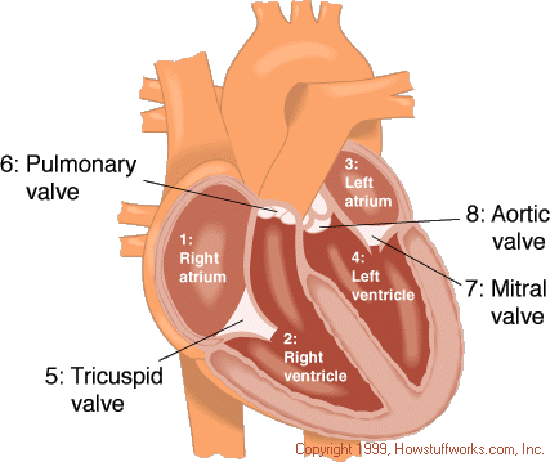The Human Heart
While we have many sentimental ideas about our hearts and we know that they are vital to our survival, when you get right down to it the heart is an elaborate and complex pump (Bianco, 1998). In the average lifetime, a heart beats over two and a half billion times and experiences no rest breaks (The Franklin Institute, 1996). The sound of your heartbeat is caused by the acceleration and deceleration of your blood as it moves through the various sections of this crucial organ (Bianco, 1998).
How the Heart Works

The heart is comprised of three layers: endocardium, myocardium, and pericardium. The endocardium is the inside lining of the heart while the myocardium is the middle layer. The pericardium is a fluid filled sac that surrounds the exterior (Bianco, 1998). Once inside the heart, this organ has four open spaces, or cavities, that your blood moves through; two of the cavities are atria while the other two are ventricles. The atria are the cavities that comprise the top curved portion of the heart and the ventricles form the bottom portion (The Franklin Institute, 1996).
Each cavity has a type of one-way valve which connects to the next section that keeps your blood from flowing backwards through your heart. When the cavity or chamber contracts, this valve exit opens and allows blood to move into the next heart cavity, closing the valve with the end of the muscle contraction so that the blood does not move back (Bianco, 1998).
Your heart pumps due to a specialized group of cells that are able to produce electrical activity independently. The heart has a natural pacemaker called the sinoatrial node which is located in the right atrium. This node conducts electrical impulses to the rest of the heart through unique fibers. The cells divide charged particles and then spontaneously release some charged particles into selected cells. This action occurs multiple times per second to cause an electrical impulse to spread over the heart and force it to contract to produce a normal heart beat of 72 beats a minute (Bianco, 1998).
Keep Your Heart Healthy
Keeping your heart healthy is a crucial part of your overall health. Learning more about your body and striving to stay healthy will help you sustain a long and fulfilling fetish lifestyle. It is important to remember that what is healthy for one person may not be healthy for someone else. Take your medical history into account along with your body type and consult your physician if you have any health concerns.
Article References
Allen, M., Bagg, A., Hamilton, J., John, K., Fricker, J., de Burgh, J., et al. (2007). The Human Body Book. New York: DK Publishing.
Bianco, C. (1998). How Your Heart Works. Retrieved 11 23, 2011, from How Stuff Works: http://science.howstuffworks.com/environmental/life/human-biology/heart.htm
Discovery Communications Inc. (2000). Cardiovascular System. Retrieved 11 23, 2011, from Discovery Kids: http://yucky.discovery.com/flash/body/pg000131.html
HowToMedia. (1999). Cardiovascular System. Retrieved 11 23, 2011, from Inner Body: http://www.innerbody.com/anim/card.html
The Franklin Institute. (1996). The Human Heart. Retrieved 11 23, 2011, from The Franklin Institute: http://www.fi.edu/learn/heart/
Image References
Someone else's art deserves recognition! The images presented in this article were borrowed from the following places:
Header Image: http://imgc.allpostersimages.com/images/P-473-488-90/30/3040/29PBF00Z/posters/human-heart.jpg | Retrieved April 28, 2015
Image 1: http://static.howstuffworks.com/gif/heart2.gif | Retrieved April 28, 2015